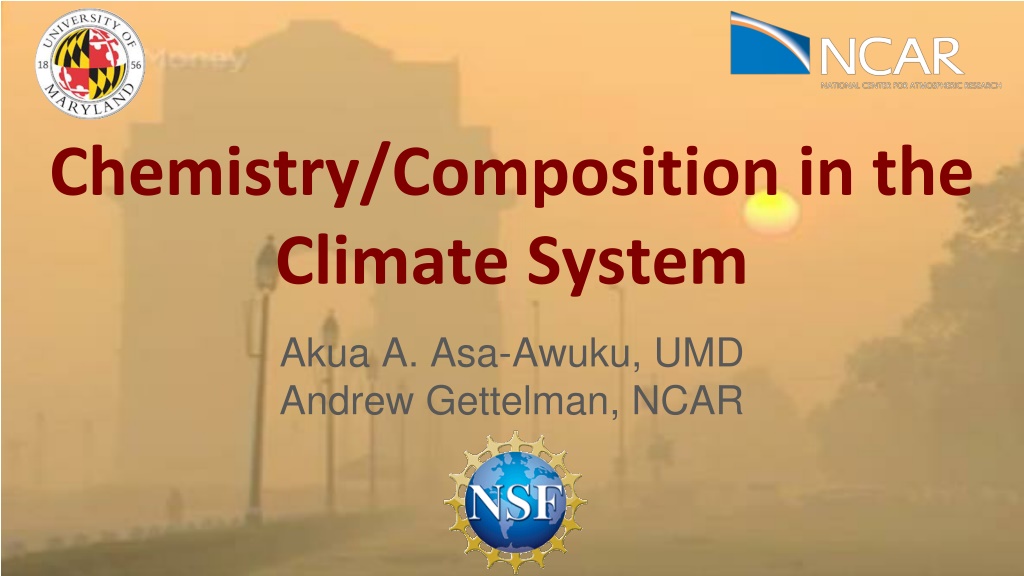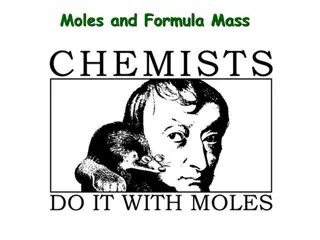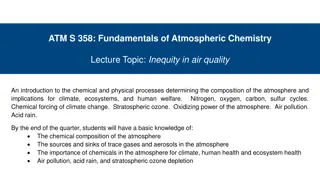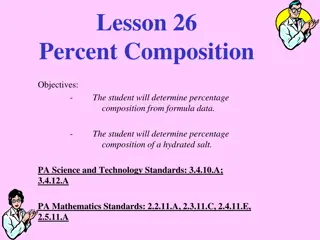Understanding Chemistry and Composition in the Climate System
Dive into the intricate relationship between chemistry and composition in the climate system, exploring topics such as radiative effects, stratosphere-troposphere coupling, aerosol-cloud interactions, and the impact of various gases and particulates on radiative forcing. Discover how changes in composition can influence atmospheric dynamics and play a significant role in shaping our climate.
Download Presentation

Please find below an Image/Link to download the presentation.
The content on the website is provided AS IS for your information and personal use only. It may not be sold, licensed, or shared on other websites without obtaining consent from the author. Download presentation by click this link. If you encounter any issues during the download, it is possible that the publisher has removed the file from their server.
E N D
Presentation Transcript
Chemistry/Composition in the Climate System Akua A. Asa-Awuku, UMD Andrew Gettelman, NCAR
Key Issues (Top to Bottom) TOA Radiative effects of Composition (e.g. Ozone, particulates) Stratospheric composition, dynamics and coupling to tropospheric climate Stratosphere-Troposphere Exchange (STE) Aerosol-Cloud Interactions (ACI) Composition Effects on Aerosols Composition Effects on Droplets Composition Effects on Scattering, Radiation (Direct Effects) Aerosol deposition on snow. Surface effects. Summary and some ideas for discussion
Overview: The Climate System Where does composition fit? CO2: Global Carbon Cycle Chemically Active Greenhouse Gases (O3, CH4, Halocarbons) Short lived Species (CO, NOx) Effects on GHGs RF feedbacks to dynamics Particulates (aerosols) Direct: Scattering Absorption Cloud - Aerosol Effects Cloud Drop Chemical effects (surfaces, radiation) Feedbacks to drops Chem Phase partitioning Surface Albedo Changes (snow)
Composition Affects Radiative Forcing Well mixed gases affect composition and RF Composition from Short Lived Gases Matters Aerosols are the largest uncertainty in Anthropogenic RF Myhre et al, 2014, IPCC AR5, Fig 8.17
Direct Radiative Effects: Tropospheric Ozone Myhre et al, 2014, IPCC AR5, Fig 8.7 (Left) & Fig 8.23 (Right)
Stratosphere-Troposphere Coupling Stratospheric Composition (e.g. Ozone Depletion) alters tropospheric circulation: Mid-Latitude Jet and Hadley Cell Position Why? Response of the Jet to UTLS temperature gradients (a result of stratospheric composition) Son et al 2009, GRL, Fig 2
Stratosphere-Troposphere Coupling (2) The mid-latitude jet responds to climate change as well as composition change. Climate change will move the jet, and affect composition: Here, variability of ozone over Eastern N. America Barnes and Fiore, 2013, GRL, Fig 4
UTLS Composition and Climate The Upper Troposphere and Lower Stratosphere (UTLS) regulates stratospheric composition and can affect radiative forcing The Tropical Tropopause Layer (TTL) sets the boundary conditions for the stratosphere E.g.: anything that affects TTL water vapor (or ozone) can affect climate (includes anthropogenic pollutants) Asian Monsoon Anticyclone is a clear example Stratospheric aerosol RF Extratropical UTLS regulates Stratosphere- Troposphere Exchange (STE) Lifetime of radiatively active Species Impacts on tropospheric Ozone Park et al 2007, JGR, Fig. 5
Aerosol Impacts A clear day in Beijing (Sep 19, 2016, 6:00 LT looking west)
Direct Impact Water Uptake Semi-Direct Effects (no clouds) Likely climatological changes in N. China Aerosol Impacts A clear day in Beijing (Sep 22, 2016, 6:00 LT looking west) PM2.5 ~80 gm-3
Aerosol-Cloud Interactions (ACI) Aerosols increase CCN Cloud drop number increases Clouds get brighter: cooling effect Magnitude (subsequent feedbacks) uncertain CCN v. Aerosol Optical Thickness Rosenfeld et al, Science 2008 Volcano Tracks Schmidt et al 2014, ACP
Aerosol-Cloud Interactions (2) Simulated effect of Aerosols: Impact of anthropogenic aerosols, per unit of AOD SW All Sky Aerosol Kernel (dR/dAOD) Challenge to go from processes and in-situ to satellite relationships Quantitative Disagreement between Observations, Small scale models, Global Models Critical uncertainties in cloud microphysical responses, feedbacks Anthropogenic Aerosol Kernel Gettelman et al 2016, J. Climate Gettelman et al 2016
Composition Effects on Aerosol CESM2, 1850 Simulations: Full (200+ species) v. simplified chemistry. Differences in SOA evolution AOD differences of 10-20% (shown) ~1Wm-2change in Cloud Radiative Effect affects ENSO AOD
Gas-phase Chemistry and Aerosol microphysics Bzdek and Reid, J. Chem Physics 2017 Transformative Pathways: Daytime Chemistry, Nighttime Chemistry, Aqueous Chemistry, Surface Chemistry Sources: Biogenic VOCs/Aerosol, Marine Aerosol, Mineral Dust, Biomass Burning, Black Carbon, Arctic Bzdek, Bryan R., and Jonathan P. Reid. "Perspective: Aerosol microphysics: From molecules to the chemical physics of aerosols." The Journal of chemical physics 147.22 (2017): 220901.
Gas-Phase and Particle Phase Partitioning (e.g., ) but not limited to: Burkart, et al. "Organic Condensation and Particle Growth to CCN Sizes in the Summertime Marine Arctic Is Driven by Materials More Semivolatile Than at Continental Sites." Geophysical Research Letters 44.20 (2017). Vizenor, A. E., and A. A. Asa-Awuku. "Gas-phase kinetics modifies the CCN activity of a biogenic SOA." Physical Chemistry Chemical Physics 20.9 (2018): 6591-6597. Sareen, N., et al. "Surfactants from the gas phase may promote cloud droplet formation." Proceedings of the National Academy of Sciences 110.8 (2013): 2723-2728. Mai,, et al. "Under what conditions can equilibrium gas particle partitioning be expected to hold in the atmosphere?." Environmental science & technology 49.19 (2015): 11485-11491. Mai et., al J. Phys Chem A. 2015.
Mixing State: Internal vs. External (e.g., ) but not limited to: Ching et al. "A three dimensional sectional representation of aerosol mixing state for simulating optical properties and cloud condensation nuclei." Journal of Geophysical Research: Atmospheres 121.10 (2016): 5912-5929. Ervens, B., et al. "CCN predictions using simplified assumptions of organic aerosol composition and mixing state: a synthesis from six different locations." Atmospheric Chemistry and Physics 10.10 (2010): 4795-4807. Gaston, C. J., et al. "The Cloud Nucleating Properties and Mixing State of Marine Aerosols Sampled along the Southern California Coast." Atmosphere 9.2 (2018): 52. Schill, et al. "The impact of aerosol particle mixing state on the hygroscopicity of sea spray aerosol." ACS central science 1.3 (2015): 132-141. Sullivan, R. C., et al. "Effect of chemical mixing state on the hygroscopicity and cloud nucleation properties of calcium mineral dust particles." Atmospheric Chemistry and Physics 9.10 (2009): 3303-3316. Wang, J., et al. "The importance of aerosol mixing state and size- resolved composition on CCN concentration and the variation of the importance with atmospheric aging of aerosols." Atmospheric Chemistry and Physics 10.15 (2010): 7267-7283. Asa-Awuku et al, 2010, JGR
Particle Morphology & Phase State (e.g., ) but not limited to: Altaf, et al. "Effect of Particle Morphology on Cloud Condensation Nuclei Activity." ACS Earth and Space Chemistry (2018). Slade, et al. "Cloud droplet activation through oxidation of organic aerosol influenced by temperature and particle phase state." Geophysical Research Letters 44.3 (2017): 1583-1591. Marsh, et al. "Amorphous phase state diagrams and viscosity of ternary aqueous organic/organic and inorganic/organic mixtures." Physical Chemistry Chemical Physics (2018). DeRieux, W., et al. "Predicting the glass transition temperature and viscosity of secondary organic material using molecular composition." Atmospheric Chemistry and Physics 18.9 (2018): 6331-6351. Freedman et al. 2009 Gorkowski, K. et al.,. "Emulsified and Liquid Liquid Phase-Separated States of -Pinene Secondary Organic Aerosol Determined Using Aerosol Optical Tweezers." Environmental Science & Technology 51.21 (2017): 12154-12163 Giordano et al, 2014, ACP
Surfactant Chemistry for Droplets (e.g., ) but not limited to: Boyer, H. C., et al., . (2016). Statistical Thermodynamic Model for Surface Tension of Organic and Inorganic Aqueous Mixtures. The Journal of Physical Chemistry A, 121(1), 198-205. Giordano, M., et al. "Changes in droplet surface tension affect the observed hygroscopicity of photochemically aged biomass burning aerosol." Environmental science & technology 47.19 (2013): 10980-10986. Ovadnevaite, Jurgita, et al. "Surface tension prevails over solute effect in organic-influenced cloud droplet activation." Nature 546.7660 (2017): 637. Noziere,B. , Baduel, C. and J. Jaffrezo. "The dynamic surface tension of atmospheric aerosol surfactants reveals new aspects of cloud activation." Nature communications 5 (2014): 3335. Sareen, N., et al. "Surfactants from the gas phase may promote cloud droplet formation." Proceedings of the National Academy of Sciences 110.8 (2013): 2723-2728. Ruehl, R. and K. R. Wilson. "Surface organic monolayers control the hygroscopic growth of submicrometer particles at high relative humidity." The Journal of Physical Chemistry A 118.22 (2014): 3952-3966. Ruehl et al, 2012, GRL
Slightly Soluble, Partially Soluble, Insoluble, Hydrophilic, Hydrophobic, Carbonaceous Compounds (e.g., ) but not limited to: El-Sayed,et al.,. "The effects of isoprene and NO x on secondary organic aerosols formed through reversible and irreversible uptake to aerosol water." Atmospheric Chemistry and Physics 18.2 (2018): 1171- 1184. Jing, Bo, et al. "Hygroscopic behavior of multicomponent organic aerosols and their internal mixtures with ammonium sulfate." Atmospheric Chemistry and Physics 16.6 (2016): 4101-4118. Xu, Lu, et al. "Chemical characterization of water-soluble organic aerosol in contrasting rural and urban environments in the southeastern United States." Environmental science & technology 51.1 (2016): 78-88. Li, K, et al. "Enhanced Light Scattering of Secondary Organic Aerosols by Multiphase Reactions." Environmental science & technology 51.3 (2017): 1285-1292. Miyazaki, et al. "Contribution of dissolved organic matter to submicron water-soluble organic aerosols in the marine boundary layer over the eastern equatorial Pacific." Atmospheric Chemistry and Physics 16.12 (2016): 7695-7707. Hayes et al, 2015, ACP
Soluble, Semi-solid, Insoluble Compounds for Ice Nucleation Knopf, D A., P. A. Alpert, and B. Wang. "The Role of Organic Aerosol in Atmospheric Ice Nucleation: A Review." ACS Earth and Space Chemistry 2.3 (2018): 168-202.
Direct Effects and Particle Scattering (e.g., ) but not limited to: Veghte, D. P., and M. A. Freedman. "The necessity of microscopy to characterize the optical properties of size- selected, nonspherical aerosol particles." Analytical chemistry 84.21 (2012): 9101-9108. Lack, et al. "Brown carbon and internal mixing in biomass burning particles." Proceedings of the National Academy of Sciences 109.37 (2012): 14802-14807. Bahreini, R., et al. "Characterizing emissions and optical properties of particulate matter from PFI and GDI light-duty gasoline vehicles." Journal of Aerosol Science 90 (2015): 144-153. Zangmeister, C. D., et al. "Measured in-situ mass absorption spectra for nine forms of highly-absorbing carbonaceous aerosol." Carbon 136 (2018): 85-93. Li., et al. "Effects of Gas-Particle Partitioning on Refractive Index and Chemical Composition of m-Xylene Secondary Organic Aerosol." The Journal of Physical Chemistry A 122.12 (2018): 3250-3260. Zangmeister et., al Carbon. 2018. Li. et., al J. Phys Chem A. 2018.
Surface Effects: Black Carbon on Snow MODIS Albedo over Greenland > 2000m 2003 Black Carbon Deposition on Snow/Ice changes albedo and surface melting Decreasing albedo as BC increases... Dumont et al 2014, Nature Geoscience
Impact of Pollution Controls on Climate Myhre et al, 2014, IPCC AR5, CH8
Summary Radiative effects of Composition are significant Stratospheric Composition impacts tropospheric climate Aerosol-Cloud Interactions impact climate: Large, highly uncertain Especially: Ice Nucleation, Cloud Microphysics Composition Effects on Aerosols: Mixing State, Morphology, Carbonaceous Compounds Droplet Surfactant Chemistry Composition Effects on Scattering, Radiation. Aerosol deposition on snow. Surface effects Climate Policy Implications of Regulation
Where do we go from here? Ideas for discussion Theme: Integrate models with observations (for climate) Test lab work in models at different scales Strategies for testing global climate impacts in lab and field (identify critical processes) Integrated modeling (include chemistry, coupled components like cryosphere) Theme: Gas and particle phase are connected: treat holistically Evolution of constituents in the climate system Pathways for Gas phase radiative forcing How do regional, persistent aspects of composition RF alter dynamics, Ts(Beijing to O3Hole) Especially: role of air pollution in regional and global climate Understand policy aspects of pollution controls and their climate impact (including aerosols) Aerosol Cloud Interactions Bridge lab particle scale studies with in situ and global impacts (integrate lab with models) Constraining cloud and aerosol microphysics from the process to global scale (key regions) e.g. carbonaceous, organics downwind of emissions, volcanoes as natural sulfur laboratories Regional scale aerosol effects on meteorology and chemistry (regional studies)























